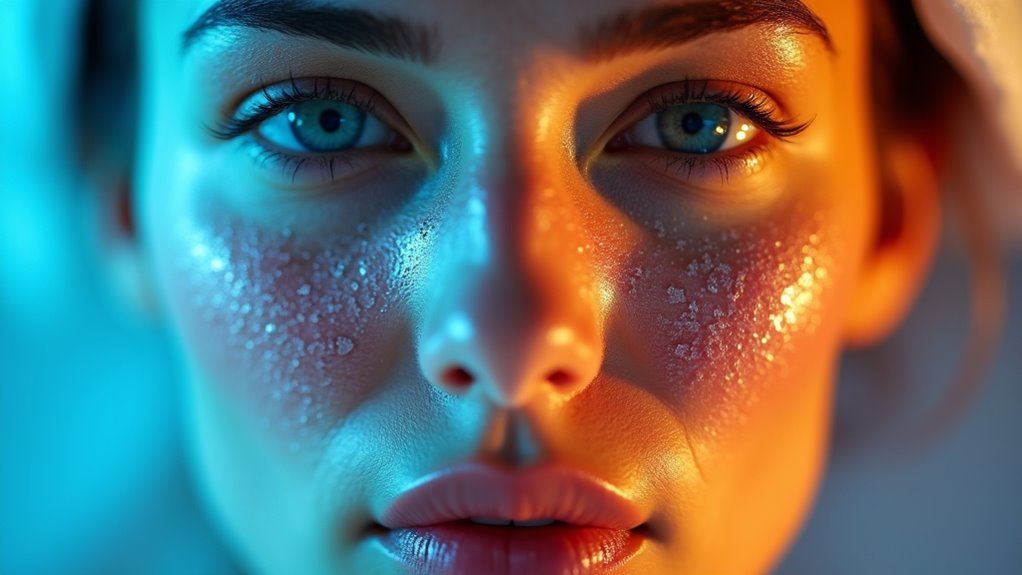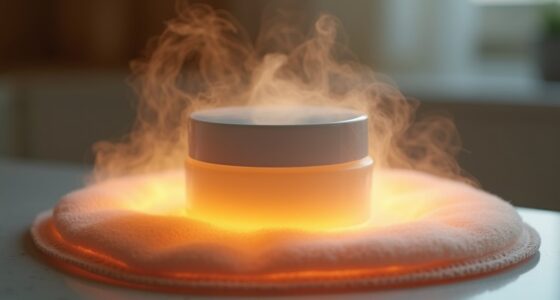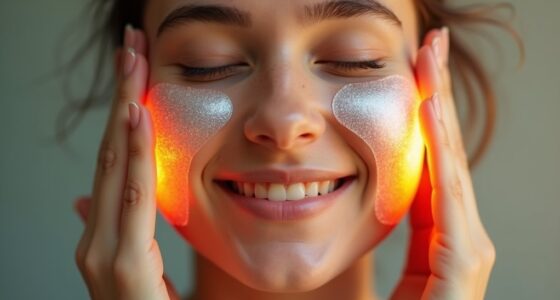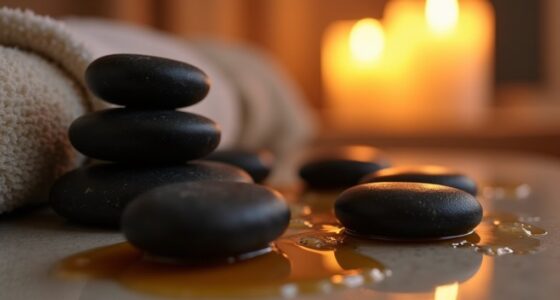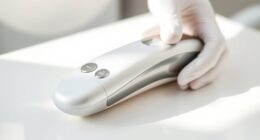Cryo treatment reduces inflammation faster than chemical peels because it rapidly constricts blood vessels and calms tissues with controlled freezing. This quick cooling minimizes redness, swelling, and discomfort, often with minimal downtime. Chemical peels, on the other hand, work gradually as they exfoliate damaged skin layers, which can prolong redness and recovery. To discover which option best suits your skin goals and how each works, explore further options below.
Key Takeaways
- Cryo reduces inflammation rapidly through quick cooling, constricting blood vessels and calming tissues, with effects visible within hours.
- Chemical peels trigger a slower inflammatory response, with redness and irritation lasting longer depending on peel depth.
- Cryo offers immediate relief with minimal discomfort and short recovery, promoting faster inflammation reduction.
- Chemical peels may cause prolonged redness and irritation, delaying the reduction of inflammation compared to cryo.
- Overall, cryo achieves faster inflammation reduction due to its rapid cooling and minimal tissue trauma.
Understanding the Basics of Cryo and Chemical Peels
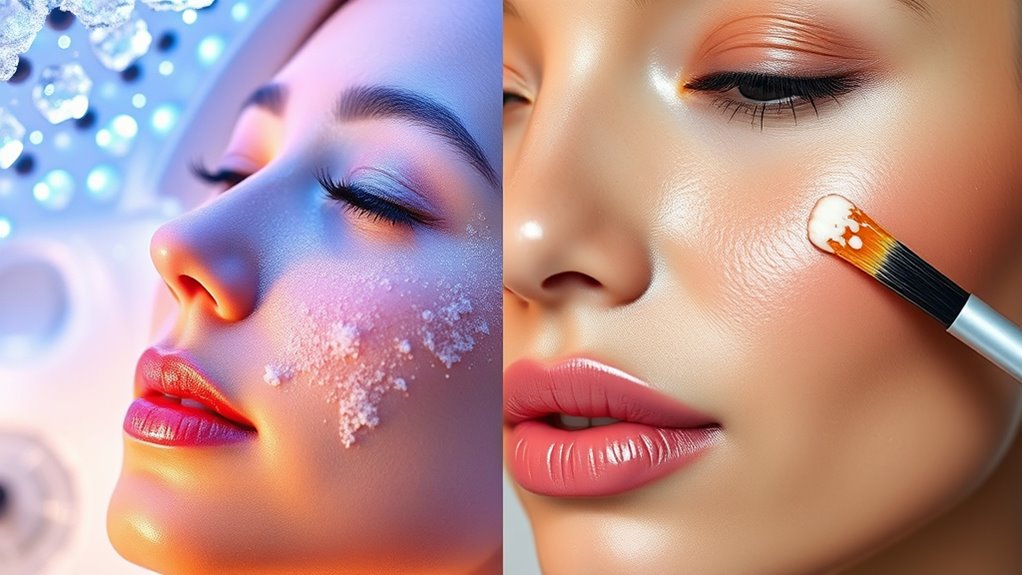
Cryo and chemical peels are popular treatments designed to improve your skin’s texture and appearance, but they work in very different ways. Cryotherapy uses extreme cold to stimulate skin renewal, reducing issues like sun damage and uneven skin tone. It’s especially effective at targeting superficial skin problems, including pigmentation caused by sun exposure. Chemical peels involve applying acids that exfoliate the outer layers of your skin, revealing fresher, clearer skin underneath. They can address hyperpigmentation and sun damage by breaking down pigmented cells and promoting new cell growth. Both treatments aim to refresh your skin, but cryo is more focused on controlled freezing, while chemical peels chemically dissolve damaged skin layers. Understanding these basics helps you choose the right option for your skin concerns. Additionally, considering the skin’s response to trauma can influence which treatment is more suitable for your specific needs.
How Each Treatment Targets Inflammation
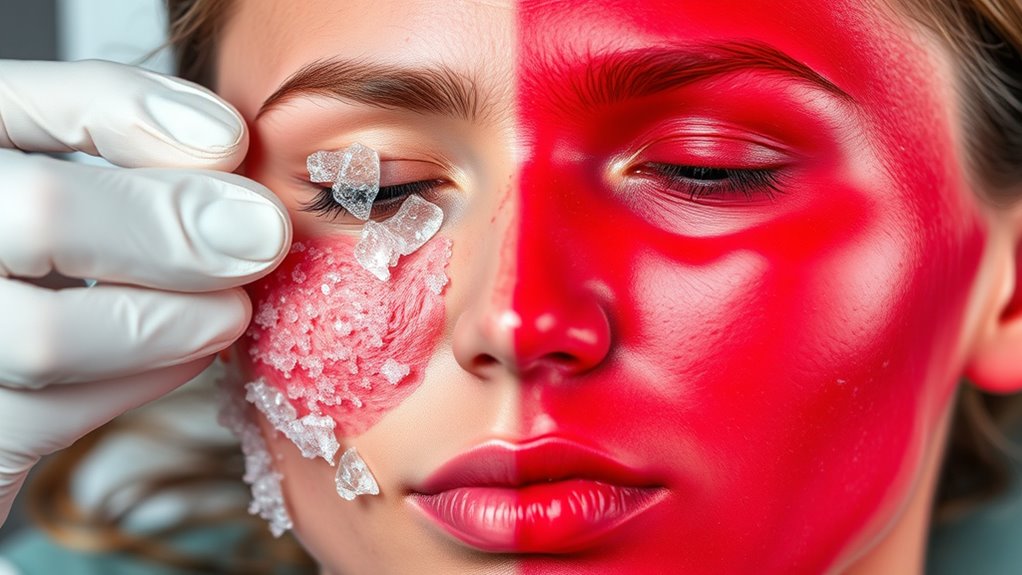
Both cryotherapy and chemical peels influence inflammation in different ways, which can substantially impact your skin’s healing process. Cryotherapy reduces inflammation by rapidly cooling affected areas, constricting blood vessels, and calming irritated tissues. This process also promotes skin hydration, helping your skin recover faster. In contrast, chemical peels work by removing damaged outer layers, triggering your skin’s natural healing response and reducing inflammation over time. To guarantee ideal results and minimize risks, it’s essential to consult with a dermatologist beforehand. They can assess your skin’s condition and recommend the best treatment plan. While cryo provides quick relief, chemical peels offer a deeper, longer-lasting reduction of inflammation. Understanding how each targets inflammation helps you make an informed decision aligned with your skin’s needs. Incorporating glycolic acid products into your skincare routine can also support the reduction of inflammation and improve skin texture over time.
Speed of Results: What to Expect Initially
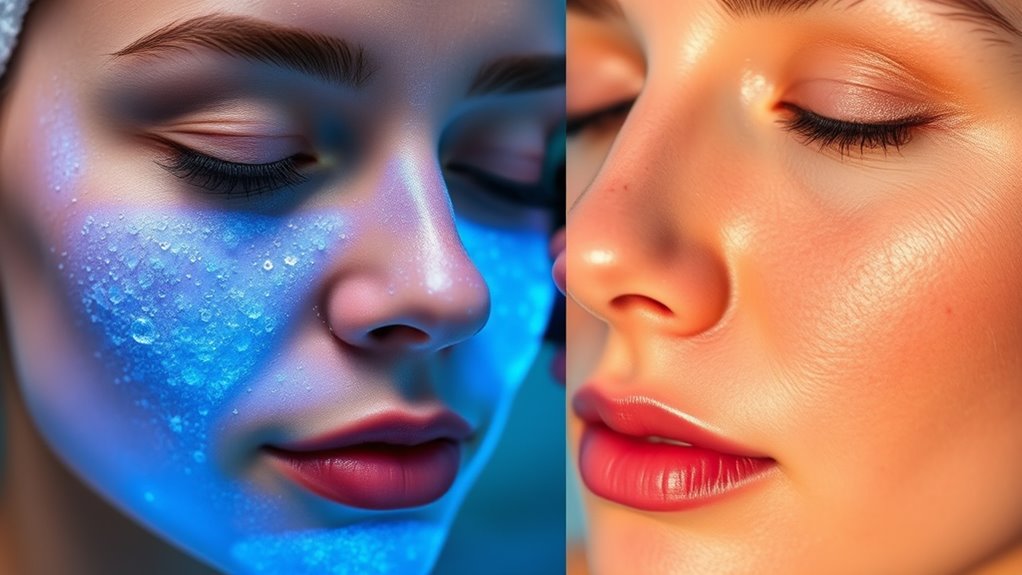
When you get a cryo or chemical peel, you’ll notice some immediate changes, but how quickly you see results varies. You might see redness or irritation right after, which typically fades within a few days. Expect some initial discomfort, but it usually settles quickly, giving you a clear idea of what’s to come. Using professional-grade equipment can also influence the speed of inflammation reduction.
Immediate Skin Response
Initially, you’ll notice that cryo treatments often produce almost immediate cooling sensations and a slight tightening of the skin, giving a quick sense of revitalization. This rapid response can feel comparable to the immediate clarity you might seek in marriage counseling, where quick relief is valued, or the swift benefits seen in pet nutrition adjustments. With cryotherapy, your skin reacts instantly, reducing inflammation and providing a cooling effect that uplifts your mood. Chemical peels, on the other hand, tend to cause a more gradual initial response, with some redness or tingling developing over hours. If you’re looking for quick, noticeable results right after treatment, cryo offers an immediate and refreshing experience, similar to the fast relief and clarity sought in other areas of personal well-being. Additionally, the use of low-carb and keto-friendly oils can support skin health and reduce inflammation over time.
Visible Redness Timeline
After experiencing the immediate cooling and tightening from cryo treatments, you might wonder how quickly visible redness appears and how it progresses. Thanks to recent tech advancements, cryo procedures now deliver more controlled and predictable redness timelines. Typically, redness appears within hours, peaking around 24 to 48 hours, then gradually subsides as healing progresses. Chemical peels tend to cause more initial redness, which can last longer depending on the peel’s depth. Your practitioner’s expertise plays a vital role in managing expectations and optimizing results. Skilled practitioners tailor treatments, minimizing unnecessary redness and accelerating recovery. Additionally, contrast ratio influences how the skin’s response appears visually, impacting the perceived redness and overall healing process. Ultimately, the visible redness timeline varies based on treatment type, skin sensitivity, and practitioner skill, but advancements in technology ensure more consistent, faster results for both procedures.
Initial Discomfort Levels
Cryo treatments generally cause minimal discomfort because they work quickly to cool and tighten the skin, often resulting in a tingling or numb sensation that subsides rapidly. You may experience slight redness or a cold feeling during the procedure, but significant pain is uncommon. The downtime duration is usually short, allowing you to resume daily activities quickly. When considering treatment frequency, keep in mind that cryo sessions are often scheduled every few weeks to maintain results and reduce inflammation efficiently. Additionally, the initial discomfort is usually manageable, making it a popular choice for those seeking fast relief from inflammation.
Factors Influencing How Quickly Inflammation Subsides
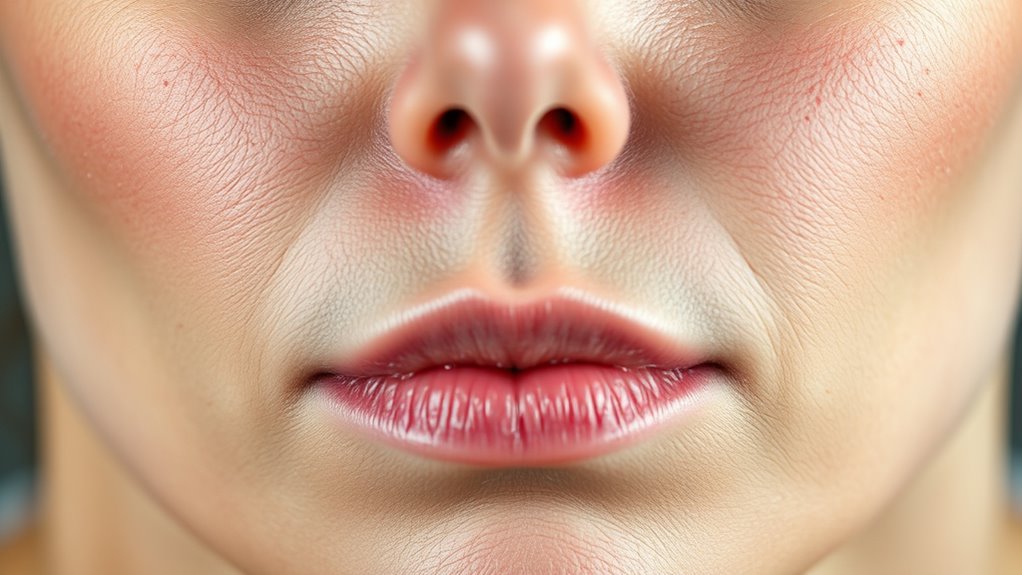
Several factors can influence how quickly inflammation subsides after cryo or chemical peel treatments. One key aspect is the theoretical mechanisms behind each procedure—cryotherapy reduces inflammation through rapid cooling, while chemical peels promote healing by removing damaged layers. Your comfort level during treatment also affects recovery, as less discomfort usually indicates less tissue trauma. Additionally, individual healing responses vary, impacting inflammation resolution speed. Understanding the distinction between Penetration Testing vs Ethical Hacking can help clarify the targeted approach for assessing vulnerabilities during recovery periods.
Comparing Recovery Periods and Downtime
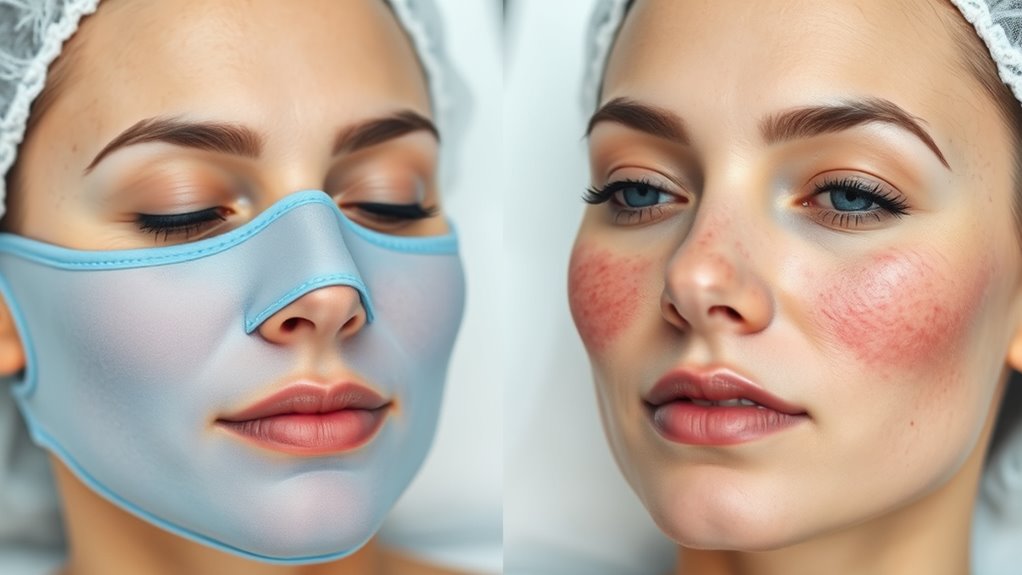
When choosing between cryo and chemical peel treatments, understanding their recovery periods and downtime is essential. Cryo sessions usually involve minimal downtime, often just a few hours to a day, allowing you to resume normal activities quickly. Chemical peels, meanwhile, can require a longer recovery, typically 3 to 7 days, depending on peel depth. Additionally, the science behind LED masks and radio-frequency wands highlights the importance of selecting treatments that align with your skin’s needs and your lifestyle. Here’s what to contemplate:
- Infection risk is generally lower with cryo due to less skin disruption, while chemical peels may have a higher risk if not properly cared for.
- Treatment duration varies: cryo is quick, often under 15 minutes, whereas chemical peels can take 30 minutes to an hour.
- Downtime impacts your schedule, with cryo being more convenient for busy lifestyles.
Side Effects and Their Impact on Inflammation Reduction
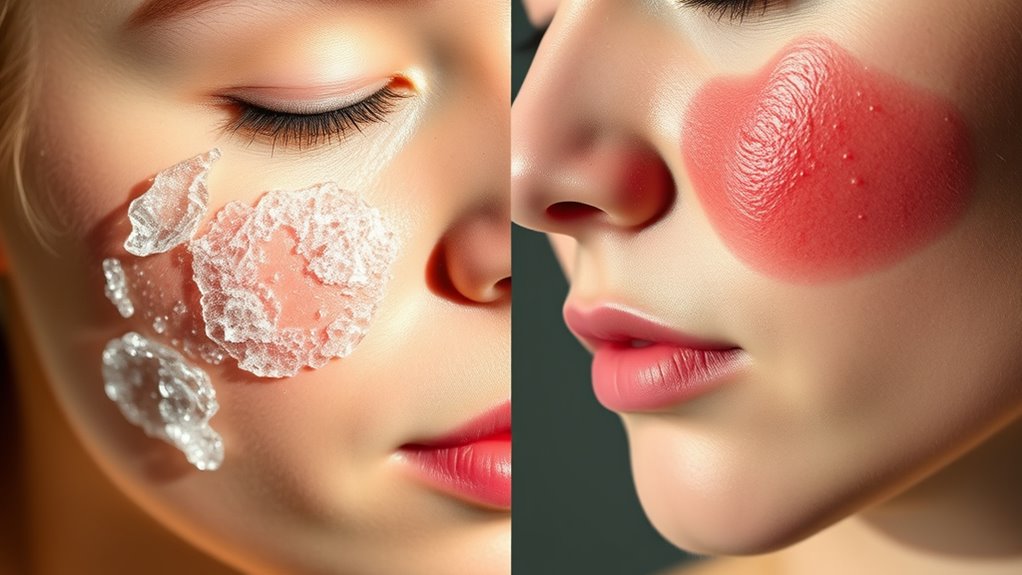
Understanding the side effects of each treatment helps you weigh their impact on inflammation reduction. Cryo treatments typically cause temporary redness, swelling, or numbness, which can briefly increase inflammation but usually resolve quickly. In contrast, chemical peels may lead to peeling, dryness, or irritation, potentially prolonging inflammation depending on peel strength. A side effects comparison shows that cryo’s effects are generally milder and shorter-lived, with less risk of prolonged inflammation. Chemical peels, especially deeper ones, can trigger more significant skin reactions, impacting inflammation longer. These side effects influence inflammation reduction because lingering irritation or damage can delay healing. Additionally, knowing how each treatment affects factors influencing healing can help you anticipate recovery timelines and outcomes. By knowing these differences, you can better anticipate how each treatment might affect your skin’s inflammation process and recovery timeline.
Suitability for Different Skin Types and Conditions
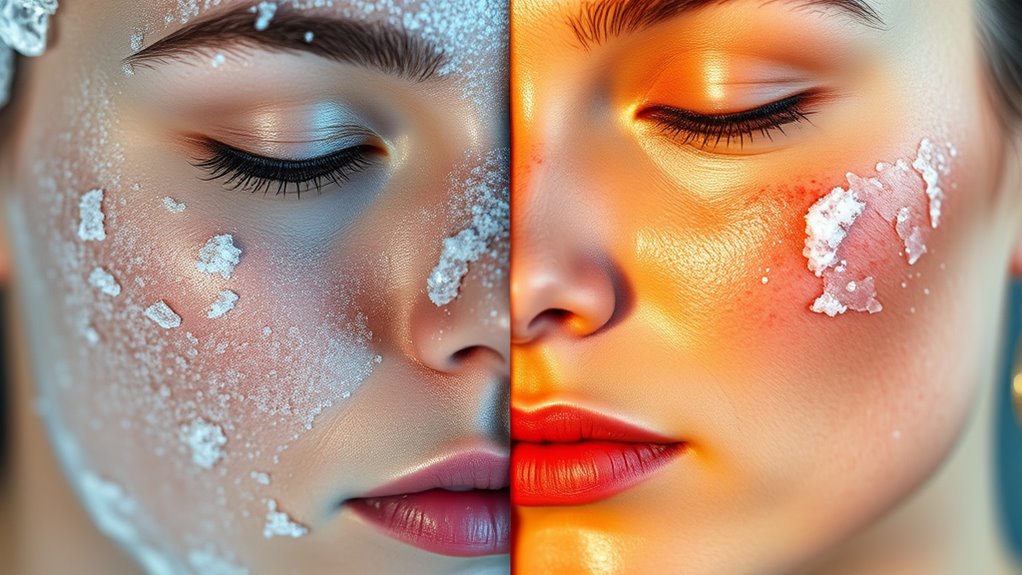
Your skin type and condition play a critical role in choosing between cryo and chemical peels. Certain treatments may suit sensitive or aging skin better, while others target specific concerns like hyperpigmentation or scars. Understanding your unique needs helps guarantee a safe and effective procedure. For instance, glycolic acid can be particularly beneficial for improving skin texture and tone, making it a good option for some skin conditions.
Skin Sensitivity Compatibility
Cryo and chemical peels differ substantially in how suitable they are for various skin types and sensitivities. If you have sensitive skin, you need to contemplate how each treatment interacts with your unique condition. For example:
- Chemical peels may cause irritation or redness, especially for those with sensitive or pediatric skin considerations.
- Cryotherapy is generally gentler but might not be suitable for all skin types, particularly if you have certain medical conditions.
- The purpose of treatment—cosmetic vs. medical—also impacts suitability, as some procedures are better suited for specific sensitivities or skin conditions.
Always consult with a dermatologist to assess your skin’s compatibility, particularly if you have underlying health issues or are considering pediatric treatments.
Age and Skin Condition
When considering cryo and chemical peels, age and skin condition are vital in choosing the right treatment. Pediatric considerations come into play, as younger skin responds differently and may require gentler options. Chemical peels are generally suitable for teens and adults with specific skin issues, but aggressive peels aren’t recommended for children. For older adults, cryo might be preferable due to its less aggressive nature. Pregnancy precautions are also important; certain chemical peels contain ingredients like salicylic acid or retinoids that aren’t safe during pregnancy. Cryo treatments tend to be safer in this scenario, but consulting your healthcare provider is essential. Overall, your age and skin condition guide the suitability of each treatment, ensuring safety and ideal results.
Specific Skin Concerns
Choosing between cryo and chemical peels depends heavily on your specific skin concerns and conditions. If you’re dealing with issues like uneven tone, acne scars, or hyperpigmentation, consider the following:
- For sensitive skin or rosacea, cryo might be gentler, but incorporating botanical remedies can soothe inflammation.
- Chemical peels work well for stubborn pigmentation or deep scars, especially when combined with lifestyle modifications like sun protection.
- Both treatments benefit from tailored skincare routines that include botanical remedies to support healing and reduce inflammation.
Always consult a dermatologist to determine the best approach for your skin type. You can optimize results by integrating lifestyle modifications and natural remedies alongside professional treatments.
Long-term Effects on Skin Calmness and Clarity
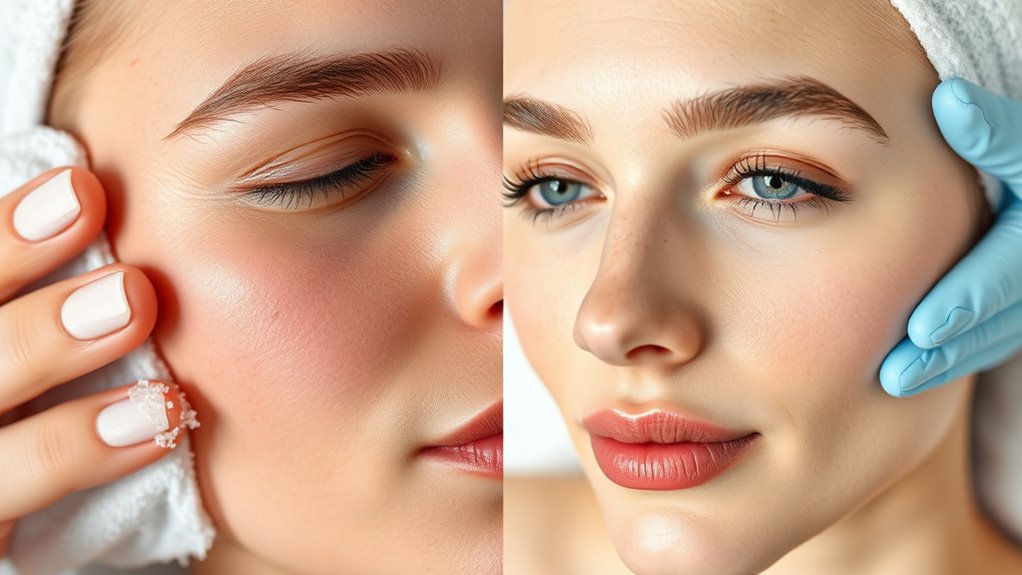
Long-term effects on skin calmness and clarity depend heavily on the type of treatment you choose. Cryo treatments often promote smoother skin texture over time, reducing pore size and enhancing overall clarity. The cold therapy constricts blood vessels, which can minimize inflammation and improve skin tone long-term. Chemical peels, on the other hand, stimulate skin renewal, leading to refined skin texture and smaller pores with consistent sessions. They also help fade pigmentation and improve clarity by removing damaged surface layers. While both treatments offer lasting benefits, your skin’s response will vary based on your skin type and goals. Regular maintenance enhances these effects, helping you maintain a calmer, clearer complexion over the long haul.
Cost and Accessibility of Cryo Versus Chemical Peels
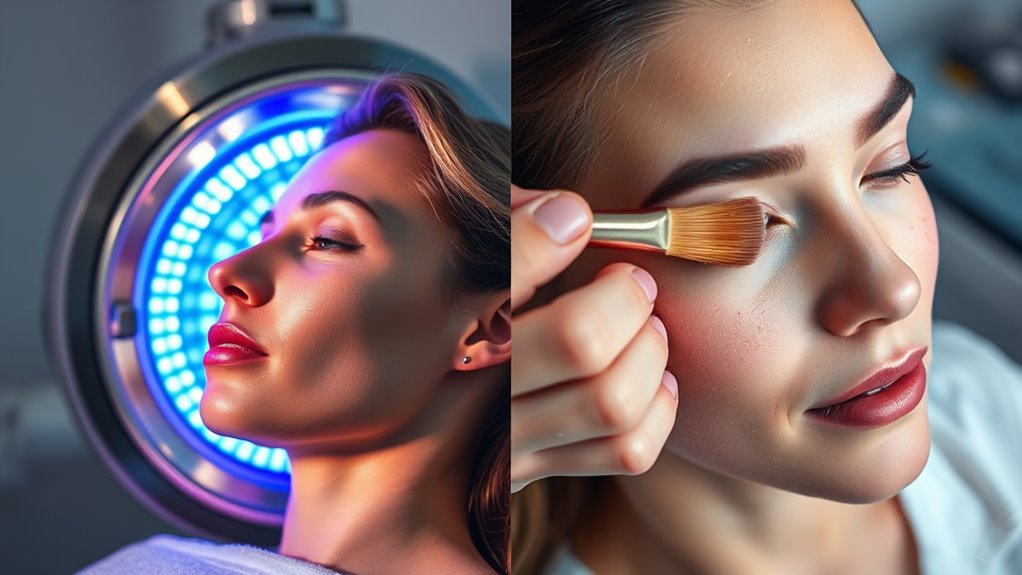
When considering cryo and chemical peels, cost and accessibility play a big role in your decision. You’ll want to compare treatment prices, availability at local clinics, and payment options like insurance. Understanding these factors can help you choose the option that fits your budget and schedule.
Treatment Cost Comparison
Cryo and chemical peels vary considerably in cost and accessibility, making it important to weigh these factors when selecting a treatment. When considering treatment cost and affordability comparison, keep these points in mind:
- Cryo treatments usually cost between $300 and $600 per session, often requiring fewer sessions.
- Chemical peels range from $150 to $300 per session, but may need multiple treatments for ideal results.
- Overall, chemical peels tend to be more budget-friendly upfront, though cryo can be cost-effective due to fewer sessions needed.
Your choice depends on your budget and desired outcomes. Cryo might be more economical long-term if fewer sessions are preferred, while chemical peels often have lower initial costs. Both options impact your treatment affordability comparison differently.
Accessibility and Availability
Have you considered how the accessibility and availability of cryo treatments compare to chemical peels? Generally, chemical peels are more widely available, especially in dermatology clinics and med spas, making them easier to find. Cryo treatments may be limited to specialized providers or larger cities, affecting accessibility. The cost comparison also plays a role; chemical peels tend to be less expensive upfront, but patient preferences vary based on convenience and treatment options. Here’s a quick overview:
| Aspect | Chemical Peels | Cryo Treatments |
|---|---|---|
| Availability | Widely accessible | Limited, specialized clinics |
| Cost Comparison | Generally lower cost | Often higher cost |
| Patient Preferences | Preference for convenience | Preference for innovative tech |
Ultimately, your choice depends on what’s available nearby and your personal priorities.
Insurance and Payment Options
Insurance coverage and payment options substantially impact your ability to afford cryo treatments and chemical peels. The cost comparison varies, influencing treatment accessibility for many. Typically, chemical peels tend to be less expensive upfront, but multiple sessions may be needed. Cryo treatments often cost more per session but can sometimes require fewer visits for desired results. To navigate these options, consider:
- Checking if your insurance covers any part of the procedure.
- Exploring clinics that offer payment plans or discounts.
- Comparing the total cost over multiple sessions for both treatments.
Understanding these factors helps you make informed decisions based on your budget and treatment goals. Ultimately, your choice depends on balancing cost, treatment accessibility, and the inflammation reduction benefits you seek.
Making the Choice: Which Is Faster for Your Skin Goals
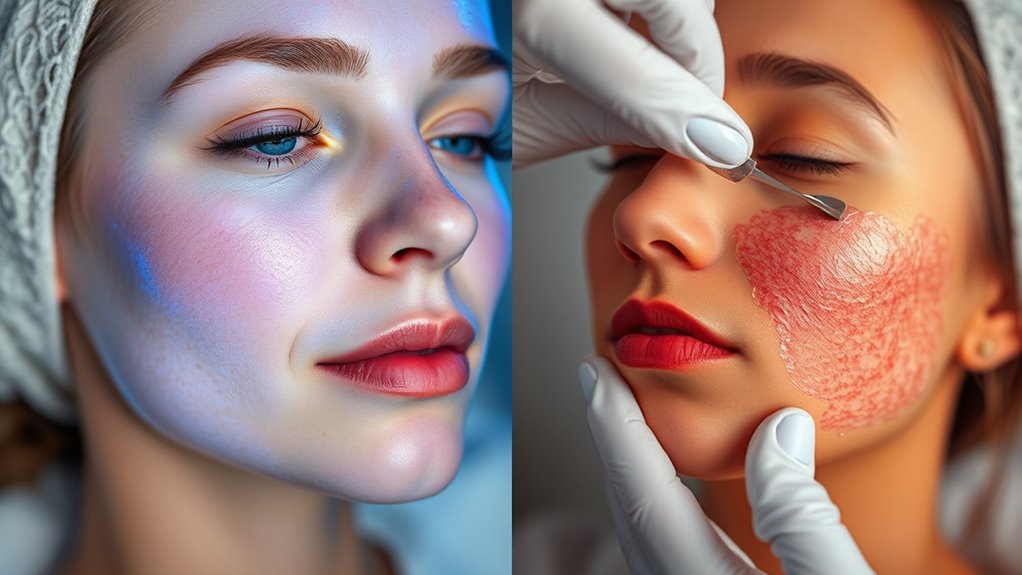
When you’re enthusiastic to see noticeable results quickly, understanding which treatment works faster can help you make an informed decision. Cryo treatments typically offer faster inflammation reduction, making them ideal if you want rapid skin improvements. Chemical peels, however, may take a bit longer but provide deeper exfoliation and skin renewal over time. If your goal is quick skin hydration and minimizing redness, cryo might be the better choice. Remember, regardless of the procedure, protecting your skin with sun protection is essential to maintain results and prevent further damage. Consider your skin goals and lifestyle when choosing. If speed is your priority, cryo can deliver faster relief, but chemical peels may offer more extensive benefits with patience.
Frequently Asked Questions
Can Combining Cryo and Chemical Peels Enhance Inflammation Reduction?
Combining cryo and chemical peels can enhance inflammation reduction through combination therapy. You might experience inflammation synergy, where the cooling effect of cryo calms skin quickly, while chemical peels target deeper layers. This synergy can speed up healing and reduce redness more effectively than individual treatments. Always consult with a skincare professional to guarantee this combination suits your skin type and to avoid potential over-treatment.
Are There Specific Skin Conditions That Respond Better to One Treatment?
Ever wondered if your skin condition prefers one treatment over another? If you’re dealing with rosacea management, gentle chemical peels might be your best bet, as they reduce inflammation without irritation. For stubborn acne, cryo treatments can help calm inflammation quickly. You should consider your skin’s specific needs and consult a specialist to determine whether chemical peels or cryo will give you the best results for your unique condition.
How Do Climate and Environment Affect Treatment Effectiveness?
Climate and environment profoundly impact your treatment results. High humidity levels can increase skin irritation or swelling, potentially slowing recovery. Pollution exposure may clog pores and worsen inflammation, making treatments less effective. You should consider these factors and protect your skin accordingly—use barrier creams or antioxidants, and avoid polluted environments when possible. Adjusting your skincare routine based on climate helps guarantee quicker healing and better overall results.
What Are the Long-Term Impacts of Repeated Treatments on Skin Health?
Imagine your skin as a delicate garden that needs care. Repeated treatments can influence skin aging and collagen production over time. While they may boost collagen temporarily, overdoing it might lead to diminished skin elasticity or uneven texture. You should weigh the benefits against potential long-term impacts, ensuring your approach promotes healthy, youthful skin without accelerating aging. Regular, balanced treatments help maintain your skin’s vibrant, resilient glow.
Do Age and Skin Maturity Influence Inflammation Recovery Speed?
Age factors and skin maturity definitely influence how quickly your skin recovers from inflammation. As you age, your skin’s natural healing processes slow down, meaning mature skin might take longer to reduce inflammation. Younger, more resilient skin tends to recover faster due to better cell regeneration. So, understanding your skin’s maturity level helps you choose treatments that align with your recovery pace, ensuring better results with less downtime.
Conclusion
Think of your skin as a garden in need of quick relief. Cryo treatments can be like a sudden rainstorm, calming inflammation rapidly, while chemical peels are more like gentle sunshine, working steadily over time. If speed is your priority, cryo might be your best bet. But remember, each treatment has its own rhythm. Choose what aligns with your skin’s needs, and watch your skin blossom into calm, clear beauty.
